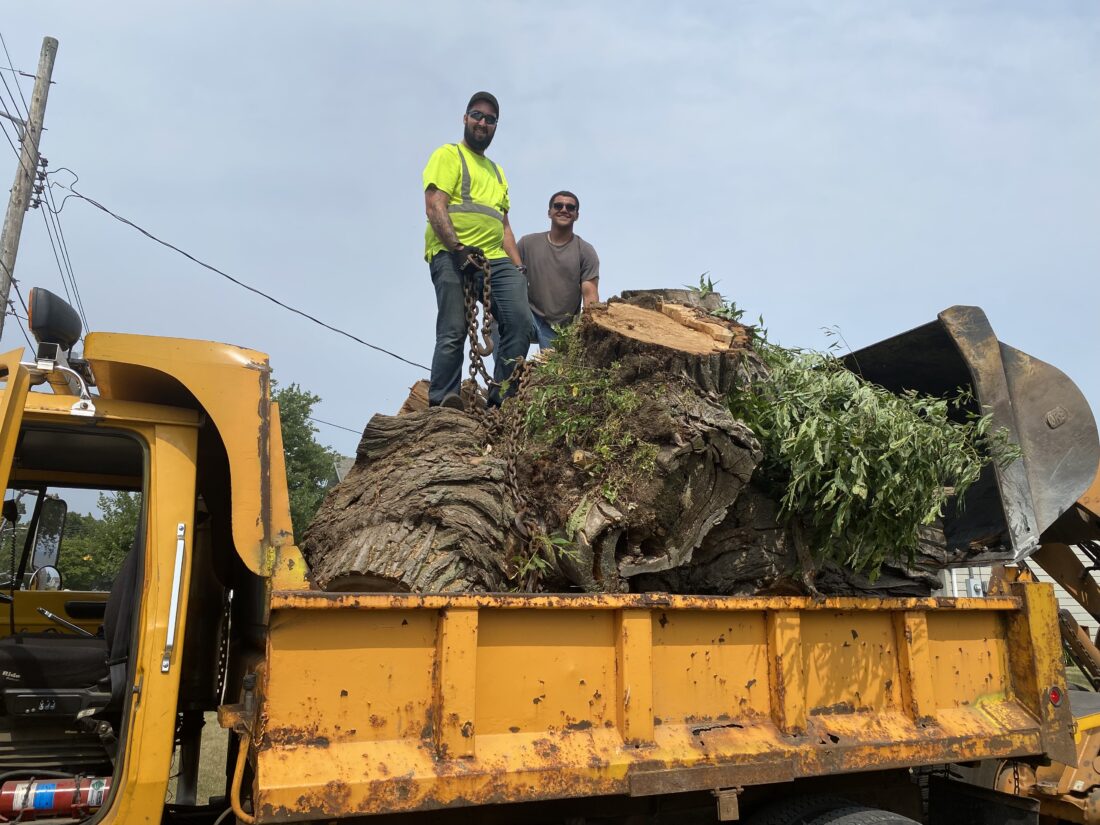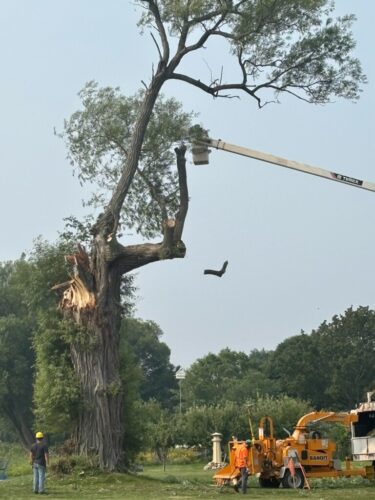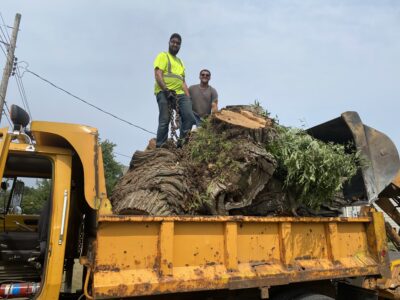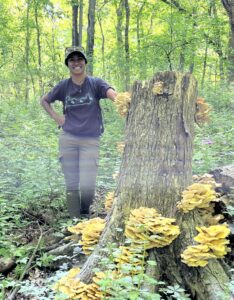Old tree reaches its end of days

Courtesy photo Andrew Hardy, left, and Aiden McNair, right, stand with a section of a black willow tree in a City of Escanaba dump truck after the unusually large and long-lived tree was cut down on Lake Shore Drive recently.

Photo courtesy of Jeff Alimenti
An Escanaba Department of Public Works (DPW) crew works to remove a 120-plus-year-old willow tree on Lake Shore Drive after a huge branch fell, leaving the wound seen at left. It took half a week to get the whole tree down.
rbranstrom@dailypress.net
ESCANABA —
A massive tree thought to perhaps be the largest in Escanaba reached the end of its life this week.
The black willow stood along the shore of Little Bay de Noc between 1021 and 1105 Lake Shore Drive on a city-owned right-of-way. The city maintained it for ages, including its multi-day removal after a huge branch fell on Aug. 4, revealing the willow to be partially rotted and potentially dangerous.
When Donald and Theresa Alimenti moved to 1021 Lake Shore Drive in 1968, the next-door neighbor was Walter Jepson, who at one point had owned a grocery store at 526 S. 10th St.
Jepson, who was born before the turn of the century, told them he had planted the tree between their properties himself when he was only about six or seven years old — placing the tree in that spot since around 1903.
Black willows (Salix negra) are fast-growing trees tolerant to wet sites with clay, loam or sandy soils. They reach heights of about 40 to 60 feet, and their “estimated life span averages 65 years with a range of 40 to 100 years,” according to the USDA.
As best estimates place the lakeshore willow at over 120 years old, it was certainly an exceptional specimen. Though the Minnesota DNR states that the diameter for a black willow can be “up to 30 inches,” the one planted by Jepson had grown to a diameter of about 85 inches, or seven feet, at chest height. Its circumference was approximately 22 feet.
At one point decades ago, a tire swing had hung from the tree, to the benefit of Don and Theresa’s seven children.
One, Christine Alimenti, believes Jepson staked it to make sure it grew nice and straight. Theresa said that black willows have a tendency to lean and only grow so high before they branch out and fall over.
“There were a lot of them next door to us that had done that — just fell over as they got older,” Theresa said. “When he planted that, he must have taken good care to make sure it stood straight up as it was growing, you know? And that’s how it got so tall.”
The last few years of the tree’s life, it required regular maintenance by the city.
“It’s a tree that we’ve been visiting four or five times a year the last couple years, with tree branches after several different storms and trimming it and trying to keep it as long as possible,” said Escanaba Department of Public Works (DPW) Director Kent Dubord.
Most recently, before the branch forming the northeast side of the crown fell, Jeff Alimenti — Theresa’s son — said that he had heard creaking for a few days.
It was Monday that the enormous branch, about three feet wide, could no longer support itself. The top crashed to the ground, its base still hanging from the trunk, which revealed a massive wound.
Jeff called the city to alert them. The DPW arrived within a few hours.
“Once we got that hanger out on Tuesday, it was determined that the tree was completely hollowed out on the inside and it became a safety hazard, so it was going to need to be removed,” Dubord said.
Theresa said that she was disappointed, but understood that it was time to accept the tree had to go.
The Alimentis were impressed by the safe and skillful way the crew handled the job: “They carefully assessed it every step of the way,” Jeff said.
The lead employee on the task, Jason Braun, has been involved with the removal of over 700 trees in the last four years, Dubord said. Both full-time and seasonal employees tackled the job to remove the willow; working on it were Andrew Hardy, Brandon Gardner, Tim Kidd, Ronald Portillo, Aiden McNair and Timothy Hoffmeyer.
With a bucket truck, a backhoe, a chipper, and a couple dump trucks, the crew finally got the tree down and out on Wednesday. Left now is a stump eight feet wide at the base, with a rotted-out hole over a foot wide in the middle.
“It took some time, because our equipment isn’t designed to cut down a stump that’s eight feet,” Dubord said. “Typically, the majority of our stumps are in the 15- to 35-inch range. And then every once in a while, we’ll have a 42- or 46-inch stump. So it’s definitely a unique situation…. And to my knowledge, the biggest tree in town.”
The willow had always provided lots of shade for the Alimentis’ lawn, which already has browned in just a couple days of its absence.
Dubord said the DPW will return the remove the stump in a couple weeks.




